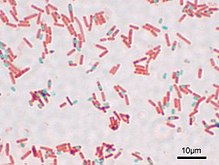Schaeffer-Fulton staining

The Schaeffer-Fulton staining (synonymous Wirtz-Conklin staining ) is a histological staining for endospores . It is a method of endospore staining .
principle
First, the bacteria are placed on a slide and fixed by heating . Schaeffer-Fulton staining uses malachite green to stain endospores and saffranin as a counterstain . The coloring with malachite green takes place under steaming with water vapor. After cooling, the excess malachite green on the slide is washed out for half a minute with distilled water. Then the safranin solution is added for two minutes. After another wash with distilled water, the slide is dried and prepared for microscopy . Alternatively, Moeller staining with carbol fuchsin and methylene blue counterstaining or Dorner-Snyder staining with carbol fuchsin and nigrosine counterstaining are used. A variant of the Schaeffer-Fulton staining was developed for staining endospores in soil samples with malachite green and crystal violet counterstaining.
history
Schaeffer-Fulton staining was developed by Alice B. Schaeffer and MacDonald Fulton at Middlebury College in the 1930s .
Individual evidence
- ^ A b John Harley: Laboratory Exercises in Microbiology , McGraw Hill, 2013. ISBN 9780077510558 .
- ↑ a b D. A. Mormak, LE Casida: Study of Bacillus subtilis Endospores in Soil by Use of a Modified Endospore Stain. In: Applied and environmental microbiology. Volume 49, Number 6, June 1985, ISSN 0099-2240 , pp. 1356-1360, PMID 16346801 , PMC 241728 (free full text).